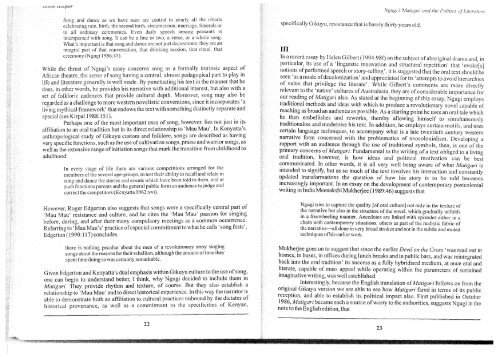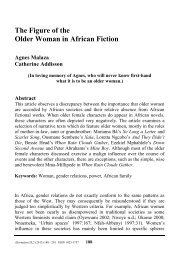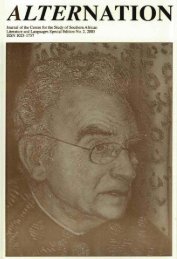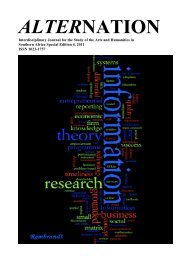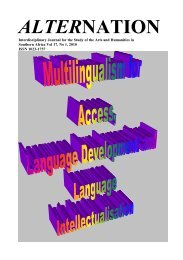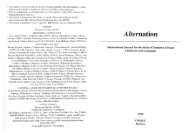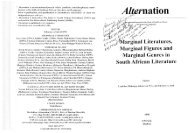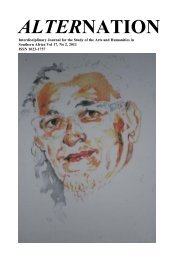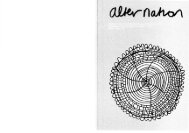Shane Moran - Alternation Journal
Shane Moran - Alternation Journal
Shane Moran - Alternation Journal
You also want an ePaper? Increase the reach of your titles
YUMPU automatically turns print PDFs into web optimized ePapers that Google loves.
Song and dance as we have Teen are ccntral to nearly all tlie i~tuals<br />
celebrat~ng ram, blrth, the second blrth, clrcumLision, marriage, funerals or<br />
to all ordlnctly cereinonies Even dally speech among peasants 1s<br />
lnterspeised wltli song It can be a line 01 two. a verse, ot a wliole song<br />
What's important IS that song and dance ale notjust decolatlons. they ale an<br />
~ntegral part of that conveisatlon, that drlnklng sesslon. that ~ilual. that<br />
ceremony (Ngugr 1986.45)<br />
While the tl-rrust of Ngugi's essay concerns song as a formally intrinsic aspect of<br />
African theatre, the sense of song having a central, almost pedagogical part to play in<br />
l~fe and literature generally is well made. By punctuating his text in the malxner that he<br />
does, in other words, he provides his narrative with additional interest, but also with a<br />
set of folkloric cadences that provide cultural depth. Moreover, song may also be<br />
regarded as a challenge to more western novelistic conventions, since it incorporates 'a<br />
living mythical framework' that endows the text with something distinctly separate and<br />
special (see Kirpal 1988: 15 1).<br />
Perhaps one of the most important uses of song, however, lies not just in its<br />
affiliation to an oral tradition but in its direct relationship to 'Mau Mau' . In Kenyatta's<br />
anthropological study of Gikuyu custom and folklore, songs are described as having<br />
very specific functions, such as the use of cultivation songs, praise and warrior songs, as<br />
well as the extensive range of initiation songs that mark the transition from childhood to<br />
adulthood.<br />
In every stage of life there are various competitions arranged for the<br />
members of the several age-groups, to test their ability to recall and relate in<br />
song and dance tlie stories and events which have been told to them. and at<br />
such functions parents and the general public form an audience tojudge and<br />
correct tlie competitors (Kenyatta 1962:xvi).<br />
However, Roger Edgerton also suggests that songs were a specifically central past of<br />
'Mau Mau' resistance and culture, and he cites the 'Mau Mau' passion for singing<br />
before, during, and after their many compulsory meetings as a common occurrence.<br />
Referring to 'MauMau's' practice of especial commitment to what he calls 'song fests',<br />
Edgerton (1 990: 11 7) concludes<br />
there is nothing peculiar about tlie men of a revolutionary army singing<br />
songs about tlie reasons for their rebellion, although the amount of time they<br />
spent time doing so was certainly remarkable.<br />
Given Edgeston and Kenyatta's dual emphasis within Gikuyu culture to the use of song,<br />
one can begin to understand better, I think, why Ngugi decided to include them in<br />
Matigari They provide rhythm and texture, of course. But they also establish a<br />
relationship to 'Mau Mau' and to direct historical experience. In this way thenarrator IS<br />
able to demonstrate both an afiliation to cultural practices unbound by the dictates of<br />
historical provenance, as well as a commitment to the specificltles of Kenyan,<br />
22<br />
ecifically Gikuyu, resistance that is barely thirty years old.<br />
Ngz~gi :s Matigal-i ciuzcl the Polltlrs 01-1,iterntiire<br />
it essay by Helen Gilbert (1994:981) on the subject of aboriginal dl-ama and, in<br />
r, its use of a 'linguistic innovation and structural repetition' that 'evoke[s]<br />
tons ofperfor~ned speech or story-telling', it is suggested that the oral text should be<br />
n 'as alnode of decolonization' and appreciated for its 'attempts to avoid hierarchies<br />
ue that privilege the literate'. While Gilbert's coinlnents are more directly<br />
nt to the 'native' cultures of Australasia, they are of considerable importance for<br />
our reading of Matigari also. As stated at the beginning of this essay, Ngugi employs<br />
ditional methods and ideas with which to produce a revolutionary novel capable of<br />
ching as broad an audience as possible. As a starting point he uses an oral tale which<br />
then embellishes and reworks, thereby allowing himself to simultaneously<br />
ditionalise and inodemise his text. In addition, he employs certain motifs, and uses<br />
language techniques, to accompany what is a late twentieth century western<br />
e form concerned with the problematics of neocolonialism. Developing a<br />
with an audience through the use of traditional symbols, then, is one of the<br />
mary concerns of Matigari Fundamental to the writing of a text obliged to a living<br />
on, however, is how ideas and political motivation can be best<br />
ted. In other words, it is all very well being aware of what Matigari is<br />
o signify, but as so much of the text involves his interaction and constantly<br />
nsfor~nations the question of how his story is to be told becomes<br />
increasingly impostant. In an essay on the development of contemporary postcolonial<br />
writing in India Meenakshi Mukherjee (1 989:46) suggests that<br />
Ngugi tries to capture the quality [of oral culture] not only in the tevture ot<br />
the narrative but also in the structure of the novel, wh~ch gradually unfolds<br />
in a freewheeling manner. Anecdotes are l~nked with eplsodes elther tn a<br />
chain with contemporary srtuations. others as part of the real~st~c fabrlc of<br />
the narrative-all done in very broad strokes and not in the subtle and muted<br />
techniques of his earlier work<br />
Mukherjee goes on to suggest that since the earlier Devil on tlze Cross 'was read out in<br />
homes, in buses, in offices during lunch breaks and in public bars, and was reintegrated<br />
back into the oral tradition' its success as a fully hybridised medium, at once oral and<br />
literate, capable of mass appeal while operating within the parameters of sustained<br />
imaginative writing, was well established.<br />
Interestingly, because the English translation of Matigavz follows on from the<br />
original Gikuyu version we are able to see how Matigari fared in terms of its public<br />
reception, and able to establish its political impact also. First published in October<br />
1986, Matigarl became such a source ofworry to the authorities, suggests Ngugi in the<br />
note to the English edition, that


